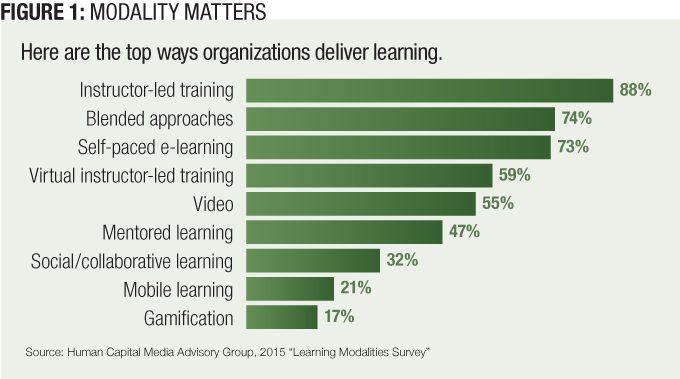Hard as it is to believe today, smartphones existed before Apple Inc. created the iPhone.
“Apple thought about software and hardware, and put it together in a tightlyintegrated system,” said John Ambrose, senior vice president of corporate development at learning company Skillsoft Corp.
The resulting device can cause city blockwide campouts with every upgrade. How can learning leaders get their employees to exhibit the same enthusiasm for a development program as they do for the iPhone 6?
“Content is not just a box of course objects that get dumped into a learning management system so learning magically happens,” Ambrose said. “The way the industry has evolved — there are companies great at building content and great at building technology, but it takes a great game changer to see that a stair-step improvement can be made by bringing those two things together.”
That’s exactly what’s happening in 2015’s learning technology industry. After a year of mergers, acquisitions and partnerships, providers are starting to connect content and technology to create single product lines that align with learners, organizations and learning leaders’ goals.
Come Together
In 2014, the content-focused Skillsoft announced its purchase of SumTotal Systems Inc., a company focused on learning technology. Ambrose said the companies continue to act as two sales organizations, but product teams have collaborated, operating with a blank slate to put together products that drive content through human resources processes from pre-hire to retirement.
Skillsoft and SumTotal weren’t alone. In November 2014, online learning platform Pluralsight made its fifth acquisition in 15 months by buying Smarterer, a skills assessment platform, for $75 million.
The acquisitions phenomenon spread beyond the learning industry. Also in November, information technology management company Xerox Corp. acquired Intrepid Learning Inc.’s learning consultancy and strategy branch to expand its employee development offerings.
Then came the billion-dollar behemoth: Professional social network LinkedIn’s acquisition of e-learning platform lynda.com. On April 9, the companies announced the $1.5 billion deal, which closed in the second quarter.
“From the point of view of the learner, some of the mergers probably are a bit unsettling,” said Nathan Chai, vice president of product operations for learning technology company Allen Communication Learning Services Inc., known as AllenComm. He referred to the Xerox-Intrepid deal as potentially beneficial to Intrepid’s clients, but how would the learning company fit into Xerox’s larger product set?
AllenComm went through its own shift this year, announcing a partnership with learning catalogue Cegos that allows them to do the same thing as Skillsoft and SumTotal— bond technology and learning. They can sell Cegos’ catalogue, and Cegos can promote their platforms.
Chai said companies that merge technology and content are more efficient for learning leaders because everything is under one vendor. They can layer functions, such as chatrooms, with content, such as meeting notes, in a way that’s streamlined and less obtrusive to employee workflows. If something needs changing or augmentation, the technical and content-focused creators can work together to develop faster fixes so learners don’t have to seek the information out for themselves.
That’s important because employees aren’t reluctantly independent. A study conducted by learning technology company Degreed in 2014 found that fewer than 12 percent of employees turn to their learning and development department for learning materials. Almost 70 percent of workers said they use Google first, and about 42 percent look for a live or online course on their own.
Employees are increasingly more proactive in their development, which means that learning technology companies are thinking smaller — targeting individual learners as well as whole organizations.
Some organizations, like Harvard Corporate Learning, have had direct-to-consumer approaches for years, said Todd Tauber, a former analyst for Bersin by Deloitte and now vice president of product market at Degreed. Not all large learning management systems companies are doing it, but he said he has seen a few make structured efforts to cater to smaller companies and individuals, like Cornerstone’s CyberU. That doesn’t mean the industry isn’t about to launch that way, however.
“For the first time ever, employees and their managers are empowered to go out and find better solutions if they want and need to,” Tauber said. “LinkedIn and Lynda is a shift from company- and L&D-directed learning to empowered, self-directed learning.”
CLO vs. DIY
When learners have this much freedom, learning leaders have to step up with enticing offerings. Not only is this apparent in the war for talent — a 2015 study by recruiting software company Jobvite found that development opportunities are the top reason 43 percent of candidates join an organization — but also in company functions.
In the past 10 years, technology usage in learning has boomed, and a lot of that has to do with the learners themselves, said Dani Johnson, who took over Tauber’s position as vice president of learning and development research at Bersin by Deloitte. Employees now demand that learning happen beyond the brick-and-mortar or virtual classroom where information once flowed from the top down. Twitter, YouTube and other social media tools allow learners to grow on their own time.
The speed of business also has put the pedal to the learning metal for CLOs. “Things are changing so rapidly that L&D, organizations and leaders have to think of how they can train the most people in the least amount of time, and make sure they’re capable of adjusting to the new business environment,” Johnson said.
With more learners seeking the technology they want to use instead of waiting for CLOs to deliver something that might be what they want, companies like lynda.com have thrived.
Tauber said the user base for the top five massive open online course companies have two-thirds as many registered users as the five biggest corporate learning content providers, even though these massive open online courses deliverers have only been around for five years. He attributes the growth to consumers looking for solutions themselves because they know how they work; a corporate-based LMS might not meet those needs.
“The big players get bigger, but … they’re less agile,” Johnson said. “There’s room for smaller innovative companies to come in.”
These small startups have equally small products, but they’ve found a home by augmenting existing programs. Johnson called it a learning technology stack. Instead of investing in an LMS, companies can look at smaller players and implement several programs that fit together. The challenge with multiple technologies is it can be more difficult to measure what works and what doesn’t — a traditional method to get executive support and funding. But Johnson said even the metrics side of learning is changing.
“It used to be important to measure everything, but now I see companies enabling solutions that don’t need to be measured,” she said. “We’ve talked to companies that are really aligned with their learning organizations, and their organizations could care less about measurement because they’re so aligned and see business results because of it.”
Versatility: Priceless
At MasterCard Inc., chief learning officer Janice Burns has found that multiple modalities mean solid results. By harnessing a passion for technology based on social learning — including MOOCs, learning communities and small private online courses, or SPOCs — MasterCard’s L&D team delivers guided learning journeys to employees that are role-specific.

For example, Burns uses the same technological platforms in varying ways based on differences in behavior, timeframes and commitments. Project managers receive six-week learning stints to hone their skills, whereas the sales branch gets the same learning over two weeks. The technology community uses the platform primarily as a social learning platform.
“Corporations and organizations are trying to replicate experiences people have outside of work within the walls of the work environment so that they are more motivated to … find time to do the learning,” she said.
Learning technology also has to integrate into a learner’s routines. Tauber said most of the infrastructure to do this — the content, technology, authoring tools and LMS — is already at CLOs’ disposal, but they operate as though they create and employees consume, rather than employees request and organizations deliver. Meeting that request-deliver dynamic doesn’t require that organizations overhaul their entire systems. Burns has augmented MasterCard’s existing programs with video, games, MOOCs and other technological modalities.
The 2015 “Chief Learning Officer Learning Modalities” survey found that although instructor-led training still leads as the top learning delivery method, blended approaches are creeping up on it in order to engage employees, increase knowledge transfer and reach larger audiences (Figure 1). Also, 75 percent of responding organizations always or often develop the same content for a variety of modalities (Figure 2).
The more a platform integrates with learners’ work patterns, the more likely learners will be to recommend it to their co-workers, Burns said. Word of mouth not only boosts voluntary development but also the L&D department’s credibility.
“The challenge for CLOs is to keep abreast of all the changes and innovators coming to the market, and create an infrastructure that’s flexible enough to bring new product, new platforms into their space, and make necessary changes when a more advanced product comes along,” she said.
Intentional Integration
Learning leaders shouldn’t start absent-mindedly adding technology systems yet, however. Intentionality is everything when there are so many options learners and organizations can pursue.

“There is the technology plan that L&D puts into place, and then all these technology that learners are using without their blessing,” Johnson said. “[CLOs] should figure out what those things are, and enable them the best they can.”
With so many employees Googling their inquiries, YouTube has become a major resource for informal learning. Video has become a much-discussed modality, as it has decreased in production cost — just take out that smartphone to film and upload a clip — and increased in popularity. But don’t go YouTube bingeing yet.
“I personally think that focusing on video is missing a big part of what’s going on,” Tauber said. “That stuff’s great because it aligns with how people are learning, but it’s not appropriate for every application and is not the whole solution for how people learn.”
Instead of getting distracted by the shiniest new object, Tauber said CLOs need to examine the dullness of their existing infrastructure. Most of the content, technology, authoring tools and LMSs available to learning leaders are built for the “we create and employees consume” mindset that no longer exists.
As organizations start pushing for more self-directed learning, their tools are struggling to catch up. For Burns, that’s where the mergers and acquisitions of the past year and a half come into play.
“These acquisitions are helping to merge together multimedia with content providers or learning platform mangers with different and new technology that may approach the space differently,” she said. “The fact that these are happening encourages innovation and creates better solutions for people in the corporate learning space.”















